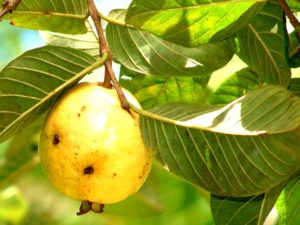The guava is a large plum-sized tropical fruit with yellow, red, or purple-black skin. Guava can be round or pear-shaped and look a bit like a quince. The guava stands 2 to 3 inches tall. Its sweet, aromatic flesh can be yellow or bright pink, or red and is moist and sometimes embedded with small, hard edible seeds. The rind softens to become fully edible but can be peeled away when the fruit is firmer.
There are as many as 150 varieties of guava. Each has its own subtly distinct flavor. One variety, the ‘Beaumont’, looks like a pale yellow lemon with smooth skin. It has a shocking pink to salmon-colored flesh and a juicy, sweet flowery flavor. Beaumont is a favorite for making guava juice.
The ‘Mexican Cream’ guava has a creamy consistency and chocolate flavor. The ‘Pear Guava’ has a tropical pear flavor. The ‘Strawberry Guava’ has dark red skin with white sweet-tart strawberry-flavored flesh. The ‘Lemon Guava’ has a lemon yellow skin and sweet tropical flavor.
Articles of interest:
Serving guava
Serve guava slices on pancakes or waffles in the morning. In the evening, pair guava slices with mild white cheese for dessert. You can even put guava slices in a baggy and send them to school or work in place of a candy bar.
The guava has the sweet flavor of a strawberry or banana or pineapple or all three. You can eat the guava out of hand or sliced or cubed and served in a tropical salad or puréed and strained to flavor poultry or pork sauces or as flavoring for mousses, ice cream bases, whipped cream, or custards.
Many guava lovers often say the larger and more pear-shaped the guava the better the taste.

How to choose guava
Select guavas that are free of bruises, blemishes, and soft spots. A just ripe guava will give to gentle pressure like an avocado. Ripe guava will have a floral aroma. Firm guavas should be ripened. An unripe guava will have an astringent taste. Avoid fruit that is spotted, mushy, or very green. Ripe guavas have a fragrant aroma.
Amount. One large guava yields ⅓ to ½ cup of sliced fruit.
How to store guava
Guavas will keep at room temperature until soft. Ripe guavas can be refrigerated in a plastic or paper bag for up to 2 days. Guavas can be puréed and frozen. Guava paste can be stored in a sealed container at room temperature indefinitely.
Guava harvest season
Guavas begin to ripen in the fall and are available until spring. The peak season is from November to March in the northern hemisphere.
About guava
Guava plants range in size from large evergreen shrubs to semi-deciduous trees that grow to 30 feet tall. The guava is native to Central America and the Caribbean. The word guava is derived from the Spanish name guayaba which was an attempted rendering of the fruit’s Arawakan language name. The Arawakan languages existed in the Caribbean, but are now extinct.
In the seventeenth century, Spanish and Portuguese sailors introduced the guava to India and Southeast Asia and tropical and semi-tropical regions around the world. Today, guava is commercially grown in the southern United States, Australia, India, Africa, Brazil, and Taiwan.
The botanical name of the guava tree is Psidium guajava. The botanical name of the shrub guava is Psidium littorale.
Garden Planning Books at Amazon:
- Vegetable Garden Almanac & Planner
- Kitchen Garden Grower’s Guide Vegetable Encyclopedia
- Vegetable Garden Grower’s Guide
- Tomato Grower’s Answer Book
More kitchen tips:
Bring your harvest to the table. Kitchen prep tips and easy recipes for the vegetables you grow. Click below for vegetable prep and recipes you can use now.
- Almonds
- Apples
- Apricot
- Aprium
- Artichoke
- Arugula
- Asparagus
- Avocado
- Bamboo Shoots
- Banana
- Basil
- Beans, Dried
- Beans. Long
- Beans, Shell
- Beans, Snap
- Beets
- Bitter Melon
- Blackberry
- Bok Choy
- Broccoli
- Broccoli Raab
- Brussels Sprouts
- Cabbage
- Cardoon
- Carrots
- Cauliflower
- Celeriac
- Celery
- Chard
- Chayote Squash
- Cherimoya
- Cherries
- Chestnut
- Chickpea
- Chinese Cabbage
- Chives
- Cilantro
- Citron
- Clementine
- Collards
- Coriander
- Corn, Sweet
- Corn, Baby
- Corn Salad, Mache
- Cranberry
- Cress
- Cucumber
- Daikon
- Dandelion
- Dill
- Eggplant
- Endive, Belgian
- Endive and Escarole
- Fava Beans
- Fig
- Florence Fennel
- Garlic
- Ginger
- Grapefruit
- Grapes
- Guava
- Horseradish
- Jerusalem Artichoke
- Jicama
- Jujube
- Kale
- Kiwifruit
- Kohlrabi
- Kumquat
- Leeks
- Lemongrass
- Lemons
- Lettuce
- Lime
- Mache (Corn Salad)
- Mandarin Orange
- Mango
- Maple Syrup
- Marjoram
- Melons
- Michihili
- Mint
- Mizuna
- Mushrooms
- Mushrooms, Cremini
- Mustard Greens
- Napa Cabbage
- Nectarine
- Okra
- Olives
- Olive oil
- Onions
- Oranges
- Oregano
- Parsley
- Parsley Root
- Parsnips
- Passion Fruit
- Pawpaw
- Peaches
- Pears
- Peas, Garden Snap
- Peas, Snow
- Pei Tsai
- Peppers, Chili
- Peppers, Sweet
- Persimmon
- Pineapple
- Pineapple Guava
- Plantain
- Plums
- Pluots
- Pomegranate
- Potatoes
- Prickly Pear
- Pumpkin
- Quince
- Radicchio
- Radishes
- Raspberries
- Rosemary
- Rhubarb
- Rutabaga
- Sage
- Salsify
- Sauerkraut
- Savory
- Shallots
- Sorrel
- Spinach
- Squash, Summer
- Squash, Winter
- Strawberries
- Sunchokes
- Sunflower
- Sweet Potato
- Swiss Chard
- Tangerine
- Taro
- Tarragon
- Thyme
- Tomatillo
- Tomato
- Turnip
- Turnip Greens
- Yams















